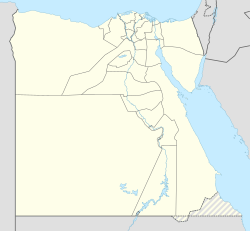Tomb of Thutmose II
| Wadi C-4 | |
|---|---|
| Burial site of Thutmose II | |
| Coordinates | 25°44′12″N 32°34′42″E / 25.73667°N 32.57833°E |
| Location | Wadi Gabbanat el-Qurud, Western Wadis |
| Discovered | October 2022 |
| Excavated by | Joint Egyptian-British archaeological expedition (2025) |
| Decoration | Book of the Amduat |
| Layout | Left-hand-turn design |
The tomb of Thutmose II, discovered in 2022[1] and attributed in 2025, is a royal ancient Egyptian tomb located in the Wadi Gabbanat el-Qurud area west of Luxor. The tomb, also known by its tomb number Wadi C-4, was identified through a joint Egyptian-British archaeological expedition. The tomb is linked to Thutmose II, a pharaoh of the 16th–15th centuries BCE. Some media outlets erroneously declared it the first royal Egyptian chamber tomb uncovered since Tutankhamun's tomb in 1922.[2][a]
Discovery
[edit]The tomb was discovered during broader archeological expeditions conducted across the Western Wadis. Initial exploration began in October 2022 with the discovery of its entrance and main passage in Wadi C west of Luxor, designated as Wadi C-4. The tomb was believed to have remained sealed since the Third Intermediate Period. Repeated flooding filled the main axis with densely packed debris that had hardened to a concrete-like consistency. This also compromised the structural integrity of the tomb's ceilings, resulting in partial collapses.[5]
The archaeological team originally suspected the tomb belonged to a royal wife due to its proximity to the tombs of three wives of Thutmose III and Hatshepsut's intended queenly burial site. Meticulous excavations continued for nearly three years before the tomb's royal ownership was confirmed.[2]
Design and architecture
[edit]The tomb exhibits a simple architectural design characteristic of the period following Thutmose II's reign, which would influence the burial structures of subsequent Egyptian rulers. The tomb's location near the Valley of the Kings and the burial sites of royal wives provides insight into the evolution of royal burial practices during the Eighteenth Dynasty.[2] The tomb was built around an early variation of a "left-hand-turn design" that became standard for subsequent Eighteenth Dynasty royal tombs.[6]
The tomb contained an "unusual" second corridor, which featured a white gypsum plaster finishing and exhibited evidence of two enlargement phases. Unlike typical tomb corridors that slope downward, the passage angles upward and intersects with the burial chamber at a height of 1.4 meters above the chamber floor. Archaeological evidence suggests this modification served as an emergency egress route after flooding.[6]
The tomb's condition was notably compromised, primarily due to flooding that occurred shortly after Thutmose II's interment. Archaeological evidence suggested that after these ancient floods, many of the tomb's original contents were moved to protect them from further damage. In the centuries after his initial burial, Thutmose II was moved to the Deir el-Bahari Cache, where his mummy was uncovered in the 19th century.[2]
Contents
[edit]The tomb's contents included several artifacts that confirmed its royal ownership. Surviving decorative elements included alabaster vessels bearing inscriptions of Thutmose II's name, referring to him as the "deceased king," and that of his wife-sister Hatshepsut.[2][6] The uncovered artifacts were the first of Thutmose II's funerary furniture to be found. Archaeologists believed that other artifacts were destroyed by tomb floods.[6]
Decoration
[edit]Many of the wall decorations have been badly damaged by the flash floods that periodically sweep through the valley. The excavation revealed mortar fragments decorated with blue inscriptions along with yellow star motifs. On fragments of a yellow-tinged background (intended to resemble aged papyrus), it was discovered that the tomb also contained portions of the Amduat, a funerary text commonly found in royal tombs of the period intended to guide deceased royalty through the afterlife.[2][6] Thus, the decoration of the tomb would have originally resembled that of KV34, the tomb of Thutmose II's son, Thutmose III.[7]
Notes
[edit]- ^ At least two royal tombs had been discovered since Tutankhamun's: that of Psusennes I in 1940[3] and that of Senebkay in 2014.[4]
References
[edit]- ^ Litherland, Piers (2023). "Has the Tomb of Thutmoses II been found?". Egyptian Archaeology. 63: 28–31.
- ^ a b c d e f Shawkat, Ahmed (18 February 2025). "Egypt announces first discovery of a royal tomb since King Tutankhamun's was found over a century ago – CBS News". CBS News. Retrieved 19 February 2025.
- ^ Bob Brier, Archaeology Archive Archived 27 December 2024 at the Wayback Machine, Volume 58 Number 3, May/June 2005
- ^ "Giant Sarcophagus Leads Penn Museum Team in Egypt To the Tomb of a Previously Unknown Pharaoh" (Press release). Penn Museum. January 2014. Archived from the original on 20 April 2015. Retrieved 16 January 2014.
- ^ "Latest Discovery in Wadi C (2022) | Theban Mapping Project". Theban Mapping Project. Archived from the original on 8 December 2024. Retrieved 19 February 2025.
- ^ a b c d e "Long-lost royal tomb of King Thutmose II finally discovered in Luxor". State Information Service. 18 February 2025. Retrieved 18 February 2025.
- ^ Mao, Frances (19 February 2025). "Thutmose II: First pharaoh's tomb found in Egypt since Tutankhamun's". BBC. Retrieved 20 February 2025.



